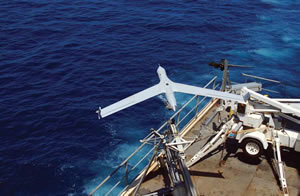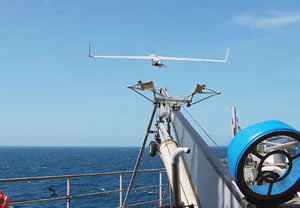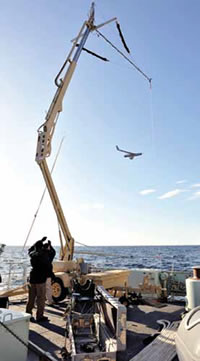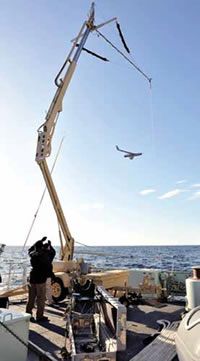Photos courtesy of Insitu

The U.S. Coast Guard command center radio crackles with an emergency dispatch: A sailboat with six people aboard is sinking 50 miles east of Cape Hatteras, but the precise location isn’t clear. Theres no EPIRB signal, just a garbled mayday overheard by a commercial ship. The weather is snotty and threatening to get worse. Within minutes, a Jayhawk helicopter and Falcon jet are airborne, roaring toward the search zone where theyll meet up with two unmanned drones launched from a cutter on patrol and already scanning the sea.
The drones, fitted with high-resolution cameras, infrared, and other sensors, cover wide swaths of ocean, flying at low altitude in windy conditions for up to 20 hours without refueling. Should they come upon mariners in distress, the drones mark the spot and instantly relay real-time video information to the cutter and a P-3 command-and-control aircraft soaring far above. Doing so allows other Coast Guard ships, planes, and helicopters capable of carrying rescue swimmers or delivering life-saving equipment to pinpoint the sailboat and assess the situation response while en route.
Sound far fetched? Not really.
Early-generation unmanned aircraft systems (UAS) armed with lightweight cameras are already being deployed on search missions in remote or deeply forested regions. These flying robots can also be used to assess conditions inside burning buildings, monitor wildfires, analyze chemical spills or gas leaks, collect weather data, find lost people, track illegal aliens, and as commercial fishermen have recently learned, keep an eye on the movement of tuna-all without putting humans in harms way.
As the technology improves, so does the likelihood that drones will prove instrumental in locating sinking boats, bobbing life rafts, or victims in the water. The drones also potentially save the U.S. Coast Guard precious time, costly aircraft fuel, and the loss of its crews should rescue efforts go bad. After all, sacrificing a next-generation micro aerial vehicle (MAV) the size of a carry-on suitcase seems insignificant compared to a downed helicopter.
Although most MAVs currently lack cargo-carrying capability because of their diminutive size, scientists are devising ways these little robots can work together to accomplish Herculean lifts. Imagine 100 determined ants marching off with your slice of cake, and you get the picture.
Vijay Kumar, a University of Pennsylvania faculty engineer researching next-generation MAVs at General Robotics, has already conducted successful experiments with 20 quad-rotor micro-drones flying in tight formation-also called swarming.
Work by Kumar and his team is significant because threat of mid-air collisions among flying drones remains of deep concern to the Federal Aviation Administration, which regulates domestic airspace.

War Spawns New Technology
Much of the present drone technology was jump-started by wars in Iraq and Afghanistan, as the U.S. military sought ways to follow enemy movements and attack targets with air-to-ground missiles, help troops avoid roadside bombs, and provide a method of exploring building interiors before sending soldiers inside. Drones have become a battlefield necessity, with futurists already predicting that 21st-century wars will be fought by robots instead of humans.
With U.S. involvement in Middle East conflicts winding down, robotics manufacturers are on the prowl for new customers, especially law enforcement agencies like the U.S. Drug Enforcement Administration and civilian-sector organizations with a need for aerial surveillance.
The Coast Guard, part of the Department of Homeland Security (DHS), is considering the purchase of relatively massive and expensive drones-similar to the Predator with its wingspan of 55 feet and a $4 million price tag. The Predator and its derivatives, like the Reaper, have been used by the CIA for surveillance and air assault in Pakistan, Yemen, and Somalia.
According to the Coast Guards Acquisition Directorate, unmanned aircraft systems (UAS) have the potential to serve as cost-effective, multi-mission surveillance platforms in the maritime environment, augmenting both cutter-based, rotary wing aircraft and land-based fixed wing aircraft.
That prediction has been born out as aerial drones fitted with cameras and other sensors now help conduct searches at sea. New products have emerged as part of this technological wave. For example, Sentient, a company based in Melbourne, Australia, has developed software called Kestrel Maritime, capable of operating from an unmanned aircraft and picking out tricky targets on an unstable sea background-i.e. life jackets.
Meanwhile, the Coast Guard has been following the U.S. Navys lead in terms of drone acquisition. In 2009, it began conducting joint maritime UAS operations with U.S. Customs and Border Protection, primarily using a version of the Predator B renamed The Guardian.
Since they can’t be launched from a cutter, the big, fixed-wing Predator-like drones might not be the best option for the Coast Guard. Besides, they require a ground crew numbering in the dozens.
Robotics experts like Peter Singer of the Brookings Institution in Washington, D.C., and author of the book Wired for War have questioned the appropriateness and usefulness of the Predator as drone of choice for the Coast Guard.
The problem for the USCG and DHS is that they too often follow the U.S. military lead and buy systems that might not be the best match for their needs, he said. This is in part because they have worse acquisition programs, but also they can be seduced by the cool factor. For example, it is arguable that much of the border patrol use of a Predator over Texas would be better done by an aerostat (radar or camera-equipped flying balloon), given that you are parked over the same plot of land all the time, rather than paying for a high-end system to burn racetracks in the air.
Singer believes drones will become a powerful tool for Coast Guard search-and-rescue missions, but emphasizes that the technology is still evolving.
Unmanned planes are where the manned plane was around 1918. So think of all the ways that they have been used since, in everything from surveillance to cargo delivery. The same is happening with robotics, where, for example, we have Global Hawks and Predators doing maritime search and robotic helicopters being used to deliver cargo to Marine bases in Afghanistan, said Singer, adding that robotic ships will soon deliver supplies as well.
In some ways, the unmanned system has an advantage for many of these roles that require long endurance to search wide areas. A pilot can’t stay up for 24 hours at a time, Singer said.
Coast Guard Drones Under Consideration
Coast Guard Lt. Cmdr. Jeff Vajda, a helicopter pilot and the services unmanned aircraft systems platform manager, said drones can take on much of the tedious work of finding those who need rescue, leaving human pilots rested and able to concentrate on the tricky maneuvers of hoisting them to a hovering aircraft.
As a pilot or search-and-rescue crew, you spend 99 percent of your time searching and then youre expected to spend 1 percent doing the most serious work when youre fatigued, he said. Soon we can let the unmanned craft do the searching and keep the crews fresh.
Until the technology advances, drones will not be lowering rescue swimmers or hoisting victims, said Vajda, adding, Were augmenting our fleet with unmanned aircraft, not necessarily replacing anything.

Vajda explained that the Coast Guard has not decided how to spend its drone budget. Were still in pre-acquisition, waiting for authorization, he said. Working with Customs has proven a cost-effective way of educating ourselves, gaining critical UAS experience. Prior to 2009, we had no skill sets. Now, we have a cadre of pilots and center operators.
According to Vajda, small UAS craft such as the ScanEagle are too light to carry a pump to a sinking boat. However, the robots big brothers, such as the Integrator, could one day in the not-too-distant future drop an EPIRB, radio, or raft. The ScanEagle can remain airborne for over 20 hours, burning a mere half-gallon of fuel. Comparatively, a Jayhawk helicopter would require more than that amount just to start its engines.
So there are the fuel savings and comparatively light maintenance costs, Vajda said, noting that several hours of pre-flight maintenance are required to launch a Jayhawk and barely 20 minutes for a ScanEagle.
On the downside, the 40-pound Scan Eagle, with its 10-foot wingspan, can’t fly in all weather conditions and isn’t able to carry an antenna big enough to obtain an adequate radar signal over a wide surveillance area. But again, new technologies are being tested that will replace radar.
As for the Predator or Guardian, the big drones have been diverted from their border patrols on at least two occasions to the Gulf of Mexico. In one incident, a man struggling to stay afloat was located by the drone and later rescued, Vajda said.
Predator-manufacturer General Atomics spokesman Kimberly Kasitz said that these were exceptions; the Predator and Guardian are not designed for search and rescue. In general, the mission of the maritime Predator B is more for combatting piracy and drug smuggling, she said. Search and rescue is not a current customer that we have.
Singer said any surveillance drone-whether its General Atomics Predator or Insitus ScanEagle, designed to fly off a boat and help fishermen find tuna-has potential applications for search and rescue, since the first priority is finding people in distress.
A ScanEagle was used by the U.S. Navy in 2009 during a standoff with Somali pirates who kidnapped Capt. Richard Phillips from the container ship M/V Maersk Alabama. The drone was designed to be sent skyward via a pneumatic launcher that can be mounted on a boat, and retrieved using a device called a skyhook, which snags the drones wing tip. It has since been updated to fly for 20 hours and be controlled from an AWAC.
The Coast Guard is now demonstrating how the ScanEagle can be used as a potential cutter-launched unmanned aircraft. Last May, a ScanEagle was test-launched from the ground near the Potomac River in Virginia by engineers at the Naval Surface Warfare Center Dahlgren Division. U.S. Navy Capt. Michael Smith, the division commander, said the demonstration proved the ScanEagle can remotely counter hostile threats by providing on-demand tactical surveillance and detection.
The ScanEagle has a 4-foot-long fuselage and is equipped with day optical and night infrared cameras, an Automatic Identification System (AIS) receiver, GPS, and full-motion video. It can provide over 15 hours of continuous day or night surveillance and is capable of a maximum altitude of 19,500 feet.
The Coast Guard conducted its first actual demonstration of a launch from a cutter in August last year. Vajda described the event, which included 11 sorties, as successful.
Ryan Hartman, vice president of business development for ScanEagle-maker Insitu, said the ScanEagle has been supporting Navy operations since 2005. We have been able to create a standard in the industry for maritime operations. The Maersk Alabama was a great example of the utility of having unmanned systems aboard, he said, noting that the drone provided U.S. special forces with covert, slow-motion video of the pirates and hostages.
Hartman said the ScanEagle increases the search footprint of a Coast Guard cutter or any ship. We can have multiple searches going on at any time. It can fly for 24 hours-plus on less than a gallon of fuel. I don’t think you could start a helicopter with a gallon of fuel, he said.
A ScanEagle was recently used to monitor whale migrations, the spread of a nuisance land-based weed in Australia, and flooding in North Dakota. According to Hartman, Insitu has helped form a team in the Pacific Northwest that can respond to emergency search-and-rescue requests as well as provide wildfire surveillance.
The Cost Factor
While a ScanEagle costs $3 million for a set of four, Northrop Grummans Global Hawk, with its 130-foot wing span and advanced sensors, is priced at a whopping $35 million per unit. Meanwhile, companies like AeroVironment (AV) in southern California are churning out tiny and far less-expensive drones such as the Puma, Wasp, and Raven, which range in weight from 4.2 to 13 pounds.
AV can make up to 100 drones per day at its Simi Valley facilities and sell them to law enforcement agencies for a couple hundred-thousand dollars apiece-another growing market. The company also manufactures the Qube, an unmanned vertical-takeoff and landing (VTOL) robotic helicopter used for surveillance and coveted by police agencies.
AVs Global Observer, currently in development and undergoing flight testing, has maritime applications because it can cover expanses up to 600 miles in diameter. Known as a HALE (High Altitude Long Endurance) unmanned aircraft system, it can fly for five to seven days and carry a payload up to 400 pounds. At 70 feet long with a 175-foot wingspan, however, the aircraft requires a runway for takeoff and landing.
Steve Gitlin, AV vice president of business development, said most systems produced by the company are designed for launch by hand. For instance, the Puma and Wasp can be deployed from a boat.
You can use these 40 miles off the coast. Our smaller ones fit in a backpack and take five minutes to deploy. If a vessel is in trouble, the Coast Guard can send up one of these and very rapidly get info on whats going on aboard the craft – a fire, a person hurt, Gitlin said. There are two cameras on board with current view and infrared, so day or night, it can stream back live wireless to the operator on the Coast Guard ship.
Gitlin said small drones launched from a ship and controlled by an on-board operator can have a distinct advantage over drones controlled by pilots sitting in a command center thousands of miles away. The people controlling it are the ones who need the information. So theres no delay, he said, noting there is also less likelihood that a timely decision will be slowed as its run through layers of bureaucracy.
These smaller systems like the Raven don’t need infrastructure. Not even a launcher because the launcher is the person. Theyre designed to land hard, which means they come apart on impact. You retrieve the parts and put them back together, he said.
With spare parts, the Raven sells for $100,000 to $200,000, depending on features installed.
The Global Observer
AVs Global Observer drone is an anomaly among the companys lineup of robots. Capable of flying at 60,000 feet above the ground, its sensors can deliver a surveillance footprint 600 miles in diameter.
Its hydrogen-fueled and can loiter over the target for a week or so, said Gitlin. Thats more than a satellite or airplane can do, and for a fraction of the cost. If you use them in pairs, one can maintain constant vigilance over the target while the other refuels, then switch.
AV engineers describe the Global Observer as a 12-mile-high tower capable of looking down at large areas even during extreme wind conditions. AV is seeking funding to continue the unmanned aircrafts development.
The Next Big Thing
The evolution of drones will change not only the battlefield but how search-and-rescue operations are conducted. The length of time drones can stay aloft is increasing exponentially. Fuel efficiency is improving, particularly among hydrogen-powered crafts, giving greater range to the search. Scanning capability on water is also getting better, allowing easier and more accurate target identification against the oceans ever-changing surface.
New, so-called morphing technology will eventually allow drones to fly in any weather condition by adjusting their shape while in flight.
On the civilian side, the French company Parrot already sells small drones that can be controlled by an iPhone, and in California, a group of fun-loving entrepreneurial engineers devised the TacoCopter which, as the name implies, delivers a taco takeout order to your door.
While Singer believes Singer drones will become a powerful tool for Coast Guard search-and-rescue missions, he points out the technology is still evolving and getting competition from other electronic locator tools. As GPS-enabled devices such as EPIRBs, PLBs and SEND devices like the SPOT and inReach gain widespread use, rescuers will already have valid coordinates to work with, he said. So in that sense, the search is being taken out of search and rescue, which means the drones surveillance capacity becomes of less value to search and rescue.
Nonetheless, knowing where victims are located doesn’t necessarily mean rescuers can reach them in time, which again calls attention to the swarming research under way by Kumar and others. As Insitus Hartman put it, the future of robotics lay in their ability to function as a group. Were working to see how to make our vehicles work cooperatively, he said.
Interestingly enough, many cutting-edge ideas for unmanned search-and-rescue robots come from The Outback Challenge, an annual competition held in Australia. In 2012, the search-and-rescue challenge for international university students and aerospace enthusiasts is focused on the fictional Outback Joe, who is lost in a remote landscape and desperately needs assistance.
The small-sized UAV (less than 220 pounds for rotary wing or 330 pounds for fixed wing) must locate the dummy within 60 minutes and deliver a package. According to the rules, once Joes GPS coordinates have been established and relayed to the judges, the unmanned aircraft must drop a 500 milliliter container of drinking water as close as possible without hitting him.
With this level of technology already in existence, it seems only a matter of time before the Coast Guard will be deploying drones on search-and-rescue missions in which the victims are delivered fresh water, a radio, life raft, and maybe even a note from home saying help is on the way.








































Can drones be equipped with radio signal receivers, for example to receive 121.5mhz for homing in sar operations at sea?
I just finished going through your article and I have to comment, it was an undivided hoot. Your writing style is so engaging, I felt like I was on a wild goose chase with you. The picture you included were also a hoot, and I’m convinced that you must have a photographic memory because they were so vivid. Keep it up, it’s a real trip!